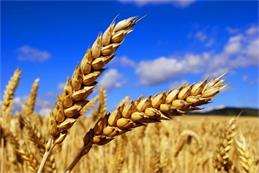TEXT А Wheat (part I)

Wheat is considered to have been the most important world cereal crop. The countries that lead in wheat production are the Soviet Union, the United States, China, Canada, India, France and Italy. Wheat ranks second1 as a cereal crop in the United States, being exceeded only by corn in acreage and in production.
Everybody knows wheat to have played an important role in the development of civilization from the earliest time. It is one of the principal sources of food for man and animals. Wheat is believed to have originated in south-western Asia.
There exist different classifications of wheat varieties. The most common classifications of wheat are those based on the time of sowing, as spring and winter wheat; on the colour of the grain, as red and white wheat, on the density of the grain, as hard and soft wheat; on the products for which they are grown, as bread and macaroni wheat; on the presence or absence of beards. As to winter wheat, it is usually preferred to spring wheat in regions where it will overwinter successfully.
We know many new varieties of wheat to have been developed, and among them lodge–resistant and shatter-resistant ones. Different cultivated varieties of wheat vary greatly in their habit, form and structure, but all are annual grasses, that is2, they require one season from sowing to producing seeds. Some important characteristics to consider in selecting a wheat variety are; (a) time of maturity, (b) winter hardiness, (c) disease and insect resistance, (d) shattering and lodging, (e) quality and yield. Yield is usually the main characteristic to be considered in choosing the variety to be grown.
Wheat is poorly adapted to warm or moist climates unless these is a comparatively cool dry season which favors plant growth and reduces the danger of diseases. The world wheat crop is grown in the temperate regions where the annual rainfall averages between 10 to 70 inches, being mostly grown in regions having precipitation of 15 to 45 inches. High rainfall, especially when accompanied by high temperatures, is unfavorable for wheat. It results in lodging, affects harvesting, threshing, storing, sowing and soil preparation. The best quality bread wheats are produced in areas where winters are cold, summer comparatively hot and precipitation moderate In general, there should be a frost-free period of about 100 days or more for safe wheat production. Quick-maturing varieties may be grown where the frost-free period is 90 days or less and where long days hasten flowering.
Notes to the text
1. ... ranks second - ... занимает второе место;
2. that is - то есть;
3. in general - в общем.
Grammar and vocabulary activities
6. Translate the following sentences with introductory there .
1. There must be mentioned two methods of sowing cereals: broadcasting and drilling, the latter being more widely used.
2. There seems to be no need of applying nitrogenous fertilizers for wheat, when it follows legumes in crop rotation.
3. There should be careful cultivation of corn soon after planting to kill the weeds at the beginning of their growth.
4. There exist many varieties of winter hardy wheat, each of them being adapted to a certain region.
5. There may be some difference in preparing a seedbed for wheat, depending on the crop, that wheat follows.








